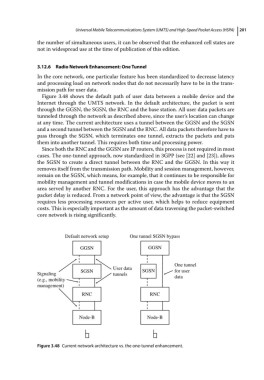Page 215 - From GMS to LTE
P. 215
Universal Mobile Telecommunications System (UMTS) and High-Speed Packet Access (HSPA) 201
the number of simultaneous users, it can be observed that the enhanced cell states are
not in widespread use at the time of publication of this edition.
3.12.6 Radio Network Enhancement: One Tunnel
In the core network, one particular feature has been standardized to decrease latency
and processing load on network nodes that do not necessarily have to be in the trans-
mission path for user data.
Figure 3.48 shows the default path of user data between a mobile device and the
Internet through the UMTS network. In the default architecture, the packet is sent
through the GGSN, the SGSN, the RNC and the base station. All user data packets are
tunneled through the network as described above, since the user’s location can change
at any time. The current architecture uses a tunnel between the GGSN and the SGSN
and a second tunnel between the SGSN and the RNC. All data packets therefore have to
pass through the SGSN, which terminates one tunnel, extracts the packets and puts
them into another tunnel. This requires both time and processing power.
Since both the RNC and the GGSN are IP routers, this process is not required in most
cases. The one‐tunnel approach, now standardized in 3GPP (see [22] and [23]), allows
the SGSN to create a direct tunnel between the RNC and the GGSN. In this way it
removes itself from the transmission path. Mobility and session management, however,
remain on the SGSN, which means, for example, that it continues to be responsible for
mobility management and tunnel modifications in case the mobile device moves to an
area served by another RNC. For the user, this approach has the advantage that the
packet delay is reduced. From a network point of view, the advantage is that the SGSN
requires less processing resources per active user, which helps to reduce equipment
costs. This is especially important as the amount of data traversing the packet‐switched
core network is rising significantly.
Default network setup One tunnel SGSN bypass
GGSN GGSN
One tunnel
User data
SGSN SGSN for user
Signaling tunnels data
(e.g., mobility
management)
RNC RNC
Node-B Node-B
Figure 3.48 Current network architecture vs. the one‐tunnel enhancement.

